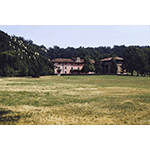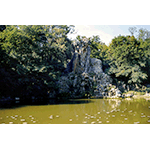Parco Mediceo di Pratolino - Villa Demidoff [Medici Park at Pratolino - Villa Demidoff]
The story of the park at Pratolino began in 1568 when Francesco I de’ Medici, Grand Duke of Tuscany, appointed architect Bernardo Buontalenti to design a villa and a large adjoining park. A few years earlier, Francesco’s father Cosimo I had been assisted by Tribolo for his gardens in Florence (Castello in 1540, the Herb Garden in 1545, and Boboli in 1550). The Pratolino project therefore began almost twenty years after that of Boboli (the park was practically completed in 1585), and Buontalenti laid it out to be a fantasy land where nature and technology blended to create a symbolic journey that would introduce the visitor to the Grand Duke’s philosophical thought. The park aroused great interest among contemporaries straightaway, and for the peculiarity of its artificial grottoes, water tricks and statues was immediately defined as "the garden of wonders". After the death of Francesco, the park met with changing fortunes. The Lorraines were totally disinterested in it and transferred many of its statues to Boboli Garden. It was only after the Napoleonic period, with the return of Ferdinand III of Lorraine, that the park reacquired new dignity. In 1818, Joseph Frietsch was appointed to redo Pratolino. He enlarged it (from about twenty hectares, it grew to roughly 80 hectares), and moreover gave it a completely new look, in line with the taste for the "English garden".
The Medici garden is today a public park, which conserves several basins, statues grottoes and, in particular, the splendid statue of the Colossus of the Apennines (1579-1580) by Giambologna. There are lawns and woods of tall oaks and cedars, and spectacularly large plane trees.
The Medici villa, today lost, on the ground floor had a complex of artificial grottoes with water tricks and automatons. The school for pages of the Medici complex, restored several times in the second half of the 18th century, was transformed into a villa by the Demidoff family in 1872.
This place is tied to events in the life of Galileo: on August 15, 1605, Galileo was sent to Pratolino to present to the Court his geometric and military compass, capable of performing numerous geometric and arithmetic operations, exploiting the proportionality between homologous sides of two similar triangles.
****************************
Texts by Paolo Grossoni
English translation by Victor Beard
Last update 15/mag/2012





